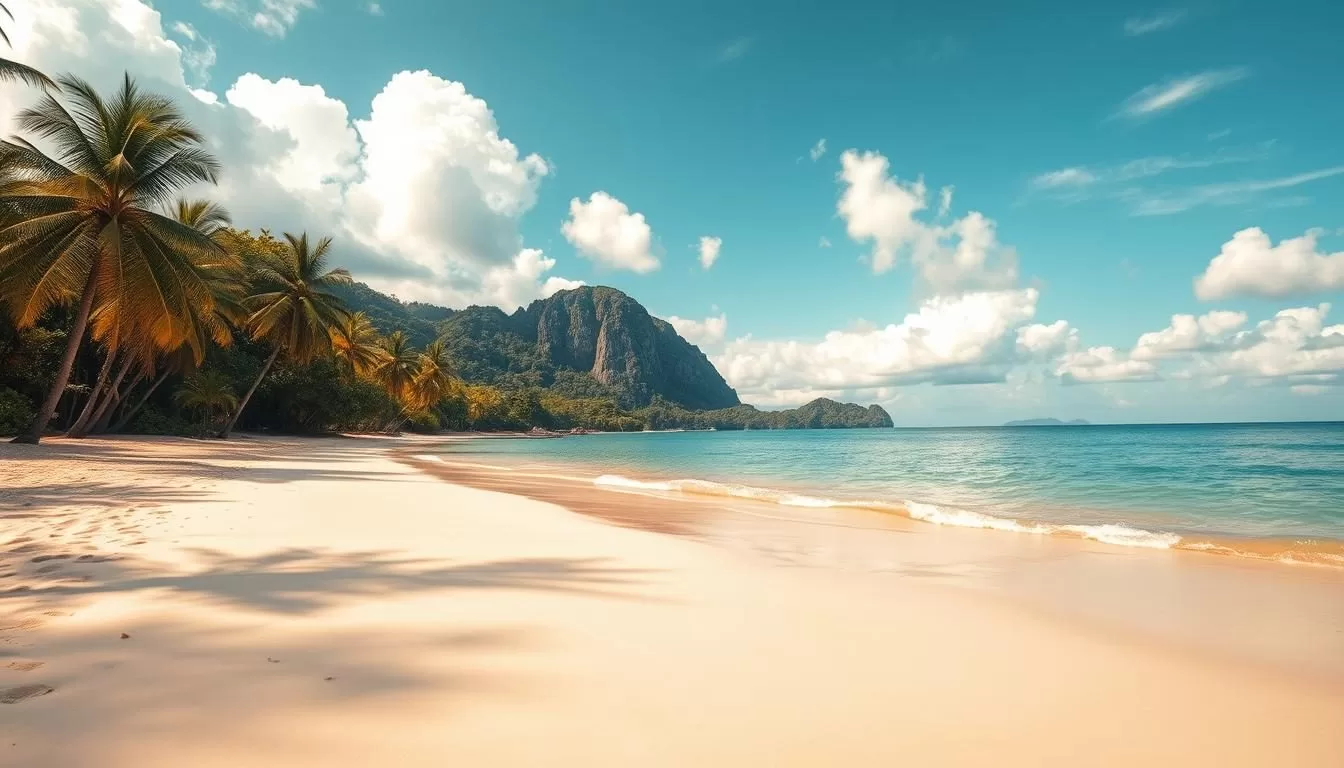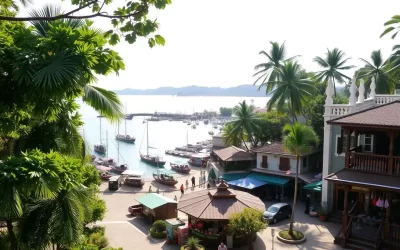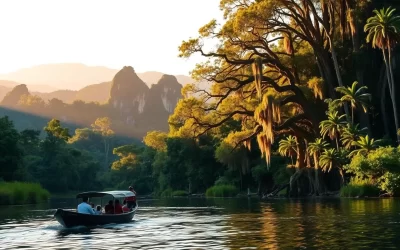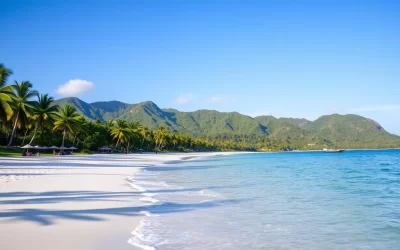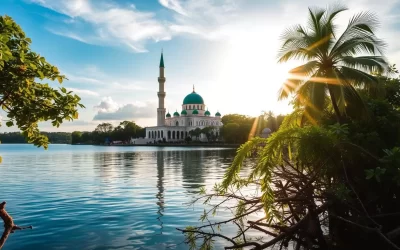Discover the hidden gem of Pangkor Island, a serene getaway in the state of Perak, Malaysia. With a population of 20,000, this charming island offers a tranquil atmosphere, pristine beaches, and rich cultural experiences.
Accessible only by ferry, Pangkor Island provides an authentic experience with its fishing villages and relatively untouched natural beauty. Whether you’re looking for a relaxing trip or an adventurous escapade, this travel guide will walk you through the top attractions and activities to make your visit unforgettable.
Get ready to explore this island paradise and create lifelong memories with your list of exciting experiences.
Discovering Pangkor Island: Malaysia’s Hidden Gem
Tucked away in the state of Perak, Pangkor Island is a charming destination that boasts pristine beaches and a rich cultural heritage. As you plan your trip, understanding the island’s location, its attractions, and the best time to visit is crucial for a memorable experience.
Where is Pangkor Island Located?
Pangkor Island is nestled on Malaysia’s west coast, approximately four hours north of Kuala Lumpur. This strategic location makes it an accessible travel guide-recommended getaway from the capital city. The island is part of the state of Perak, known for its untouched natural beauty and authentic local atmosphere.
Why Visit Pangkor Island?
Pangkor Island stands out from other Malaysian islands due to its unique blend of natural beauty and cultural heritage. The island offers a range of beaches and places to explore, making it an ideal way to experience the authentic Malaysian area. Visitors are drawn to its pristine beaches, clear waters, and abundant wildlife, including hornbills.
| Attraction | Description |
|---|---|
| Pristine Beaches | Enjoy the clear waters and untouched beauty of Pangkor’s beaches. |
| Cultural Heritage | Experience the authentic local atmosphere and cultural heritage. |
| Wildlife | Spot abundant wildlife, including the iconic hornbills. |
Best Time to Visit Pangkor Island
The best time to visit Pangkor Island is during the dry months of February, March, June, and July. The island enjoys a relatively stable, tropical climate year-round, making it a suitable destination at any time. However, the wet season, which runs from September to December, should be avoided.
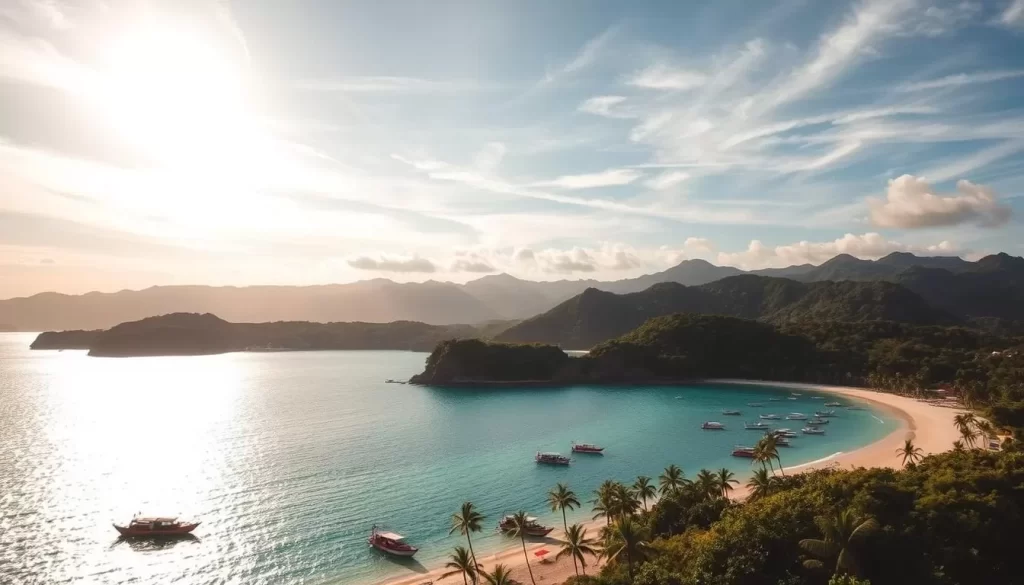
Relaxing on Pangkor Island’s Beautiful Beaches
Visitors to Pangkor Island are spoiled for choice with its array of stunning beaches, each with its own charm. Whether you’re looking for a vibrant beach experience or a secluded paradise, Pangkor Island has something for everyone.
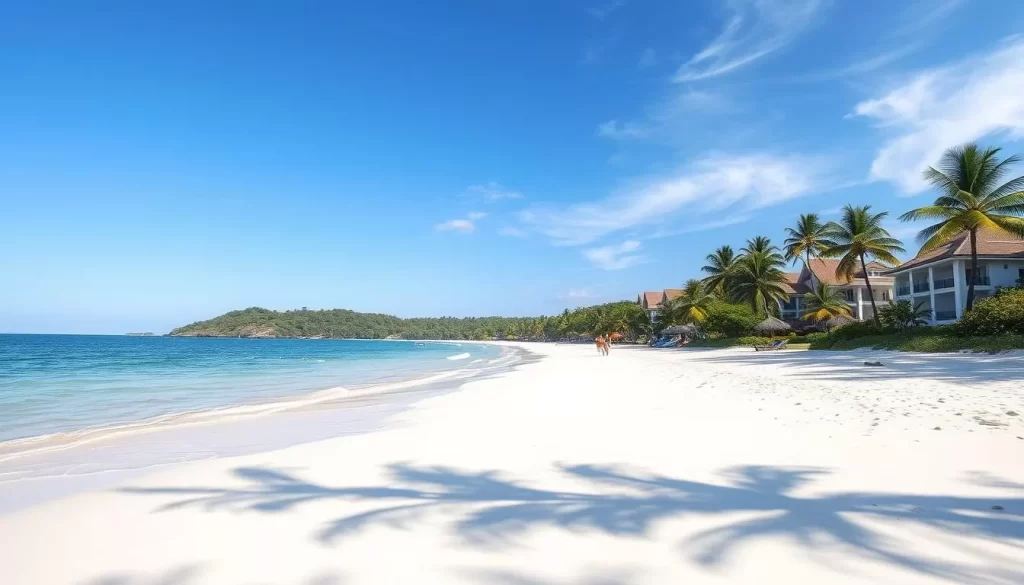
Pasir Bogak Beach: The Most Developed Beach
Pasir Bogak Beach stands out as Pangkor’s most developed beach area, featuring white sand shores lined with resorts and restaurants, making it perfect for visitors who want convenience alongside natural beauty. The gentle waves at Pasir Bogak Beach create ideal swimming conditions, especially for families with children, and the beach offers plenty of shade from trees along its perimeter.
Teluk Nipah: Perfect for Sunset Views
Teluk Nipah offers a more vibrant beach experience with numerous food stalls and restaurants directly facing the shore, creating the perfect setting for enjoying dinner while watching spectacular sunset views. You can also enjoy various water activities like jet skiing and banana boat rides.
Coral Beach: A Secluded Paradise
Coral Beach lives up to its name as the island’s premier snorkeling spot, with clear waters revealing colorful marine life just offshore. Though it’s a bit secluded and requires following a somewhat hidden path north of Lin Je Kong Temple, the effort is worth it for this secluded paradise. The westward-facing position of Coral Beach makes it the ultimate sunset viewing location on Pangkor Island.
Other notable beaches worth exploring include Teluk Ketapang (Turtle Bay), Pasir Giam Beach, and Teluk Belanga, each offering its own unique atmosphere and level of seclusion.
Exploring Historical Sites on Pangkor Island
As you explore Pangkor Island, you’ll uncover historical sites that reveal its colonial heritage. The island is home to several landmarks that have stood the test of time, offering a glimpse into its rich history.
Understanding the Dutch Fort Ruins
The Dutch Fort Ruins, also known as Kota Belanda, is a significant historical landmark on Pangkor Island. Built in 1670, it served as a strategic tin storage facility during the Dutch colonial era. The fort was once home to 60 Dutch soldiers who were stationed there to protect the valuable tin trade resources.
Today, visitors can explore the restored ruins, which have been carefully maintained to retain their historical accuracy. The fort’s missing roof is a deliberate design choice, as historians are unsure of the original roofing design. The fort is surrounded by manicured gardens and is close to beautiful beaches, making it an ideal spot for capturing memorable photos of your island adventure.
- The Dutch Fort stands as a testament to Pangkor Island’s colonial past.
- It was built in 1670 as a strategic tin storage facility.
- The fort’s restoration maintains historical accuracy, including the missing roof.
Discovering Batu Bersurat (Sacred Rock)
Just a short walk from the Dutch Fort lies the mysterious Batu Bersurat, or Sacred Rock. This ancient rock features inscriptions that have sparked local legends and historical debate. The most famous carving appears to depict a tiger devouring a child, according to local folklore, although historians believe it is actually the Dutch coat of arms etched by soldiers from the nearby fort.
Both the Dutch Fort and Batu Bersurat are conveniently located in Kampung Teluk Gedung on the island’s eastern coast, making them easy to visit together during a morning or afternoon excursion. These historical sites provide a fascinating contrast to Pangkor’s natural beauty, offering visitors insight into the island’s significant role in Malaysia’s colonial trading history.

Visiting Pangkor Island’s Unique Temples and Mosques
As you explore Pangkor Island, you’ll discover unique temples and mosques that reflect the island’s rich heritage. These religious sites not only showcase the island’s multicultural identity but also provide a glimpse into the harmonious coexistence of different faiths on this small Malaysian island.
Foo Lin Kong Temple and Its Mini Great Wall
The Foo Lin Kong Temple is a standout attraction on Pangkor Island, featuring traditional Chinese architecture and expansive gardens. The temple’s grounds include a mini replica of the Great Wall of China, a turtle pond, and the mystical “rock of fate.” This makes it a cultural and spiritual area worth visiting during your stay on the island. Visitors can explore the peaceful surroundings and capture memorable photos amidst the temple’s unique features.
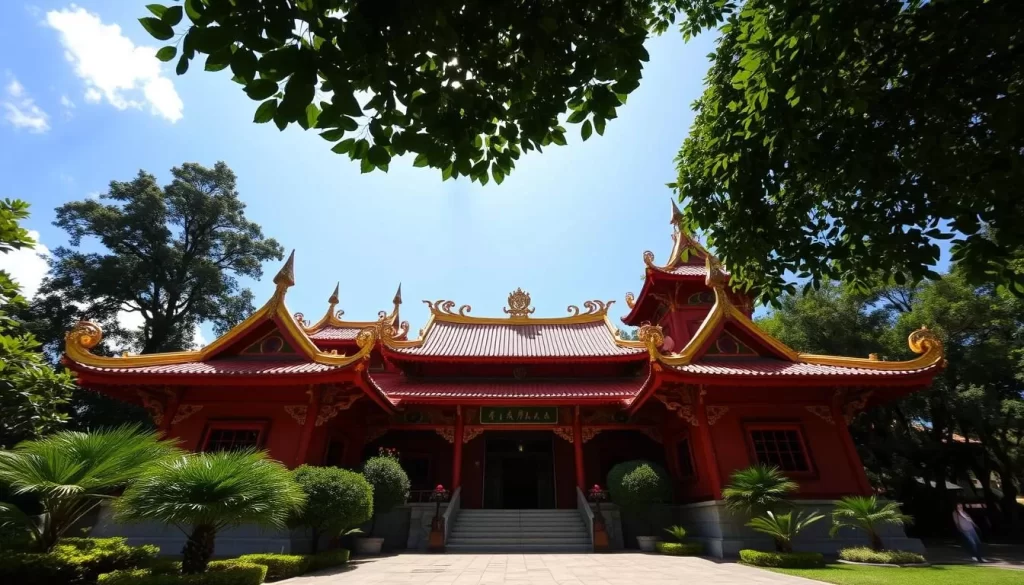
Masjid Al-Badr Seribu Selawat (Floating Mosque)
Located near the sacred rock, the Masjid Al-Badr Seribu Selawat, also known as the Floating Mosque, is a stunning visual treat. The mosque appears to hover over the water, creating a breathtaking sight. The name references the thousand prayers carved into its walls and pillars. Non-Muslim visitors are welcome to explore the mosque outside of prayer times, provided they dress modestly.
Kali Amman Temple: Malaysia’s Only Sea-Facing Hindu Temple
On the east side of Pangkor Island lies the Sri Pathirakaliamman Temple, also known as the Kali Amman Temple. It is Malaysia’s only sea-facing Hindu temple and the sole Hindu place of worship on the island. The temple is renowned for its vibrant festivals and ornate decorations, making it a popular photo spot for visitors. During festivals, the temple comes alive with colorful celebrations, attracting a number of visitors to this unique place on Island Pangkor.
Wildlife Encounters on Pangkor Island
Pangkor Island is a haven for wildlife enthusiasts, offering unforgettable encounters with nature’s wonders. The island is home to a diverse range of wildlife, including the iconic hornbill, Malaysia’s national bird.
Feeding Hornbills at Sunset View Chalet
One of the most exciting experiences on Pangkor Island is feeding the hornbills at Sunset View Chalet. Located near Teluk Nipah Beach, this chalet hosts a daily hornbill feeding event at sunset, where you can witness these magnificent birds up close and even feed them yourself. The event takes place every evening at 6:30 PM, creating a memorable experience with perfect photo opportunities.
- Enjoy a magical wildlife experience as hornbills swoop down to feast on fruits.
- Participate in the feeding ritual by holding out slices of banana for the hornbills.
- Create lasting memories with these magnificent birds.
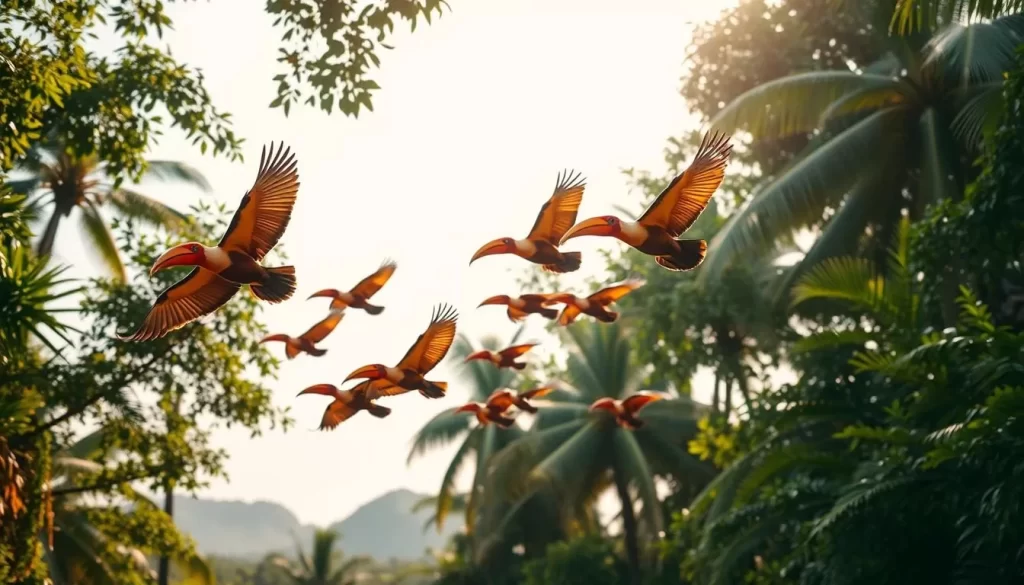
Jungle Trekking at Bukit Pangkor
For a more adventurous wildlife encounter, jungle trekking at Bukit Pangkor is a must. The trek takes you through the island’s virgin rainforest to its highest point, 350 meters above sea level. Along the way, you might spot monitor lizards, monkeys, and more hornbills in their natural habitat. Be prepared for the challenging terrain and high humidity.
- Explore the virgin rainforest and experience the island’s biodiversity.
- Reach the highest point on the island for panoramic views.
- Follow marked paths to avoid getting lost in the dense forest.
Water Activities and Adventures

The calm and clear waters of Pangkor Island make it an ideal spot for various water sports. Whether you’re an adventure seeker or looking for a relaxing experience, Pangkor Island has something for everyone.
Snorkeling in Crystal Clear Waters
Snorkeling tops the list of water activities on Pangkor Island, with crystal-clear waters revealing colorful marine life. Popular spots include Coral Beach and Turtle Bay (Teluk Ketapang), where visibility is excellent year-round. You can easily rent snorkeling equipment at most beach areas, making it convenient to enjoy an underwater adventure without bringing your own gear.
Kayaking Around the Island
Kayaking offers a peaceful way to explore Pangkor’s coastline at your own pace. Rental options are available at both Nipah Bay and Pasir Bogak Beach, where the gentle, shallow water creates ideal conditions for paddlers of all experience levels. You can explore the island’s serene waters and enjoy the scenic views.
Island Hopping to Nearby Islands
For those looking for more excitement, island hopping boat trips from Nipah Bay take you to nearby uninhabited islands like Pulau Mentagor and Pulau Giam. Here, you can enjoy pristine beaches and snorkeling spots away from the main island. You can take a boat ride to Pulau Sembilan, known for its excellent diving and snorkeling opportunities.
In addition to snorkeling and kayaking, other water activities such as jet skiing, banana boat rides, and parasailing are available at the main beaches. These activities provide thrilling alternatives to the more relaxed water experiences, ensuring that there’s something for every kind of visitor.
Pangkor Island, Malaysia: Best Things to Do for Families
You can create lifelong memories with your family on Pangkor Island, Malaysia. This island is an ideal destination for families, offering a mix of relaxation and adventure.
Kid-Friendly Beaches and Activities
Pangkor Island boasts several kid-friendly beaches, with Pasir Bogak Beach being a standout. The beach features gentle waves, clean sand, and plenty of shade trees, making it perfect for families. You can enjoy various activities like building sandcastles, swimming, and snorkeling.
Families can also engage in water activities such as kayaking and glass-bottom boat rides, which are suitable for children.
Family-Friendly Accommodations
Many resorts on Pangkor Island cater specifically to families, offering facilities like children’s pools, playgrounds, and family rooms. You can choose from a range of accommodations that suit your family’s needs.
| Accommodation Type | Facilities | Price Range |
|---|---|---|
| Luxury Resorts | Children’s pools, playgrounds, family rooms | High |
| Mid-Range Hotels | Family rooms, kid-friendly dining | Moderate |
| Budget-Friendly Inns | Basic amenities, affordable rates | Low |
Experiencing Local Culture and Food
Pangkor Island is a haven for those seeking to experience authentic Malaysian culture and cuisine. The island’s towns and fishing villages offer a glimpse into the local way of life.
Exploring Pangkor Town and Fishing Villages
When you visit Pangkor Town and the fishing villages of Sungai Pinang Besar and Sungai Pinang Kecil, you’ll discover authentic glimpses into local island life. The narrow streets are lined with traditional shops and local homes on stilts, creating perfect photo opportunities of authentic Malaysian island culture. Pangkor’s economy relies heavily on fishing, and visiting the morning fish markets provides insight into this traditional livelihood.
Must-Try Seafood and Local Delicacies
The local food scene is dominated by seafood, with must-try dishes including fried soft-shell crab, steamed fish with ginger and soy, and chili crab. You can enjoy these dishes at reasonable prices while watching the sunset over the Straits of Malacca at the northern part of Teluk Nipah. For those seeking local snacks, the area around Pangkor Town jetty offers various stalls selling Malaysian favorites.
Where to Stay on Pangkor Island
From luxury resorts to budget-friendly inns, Pangkor Island has a wide array of accommodations to suit various budgets and preferences.
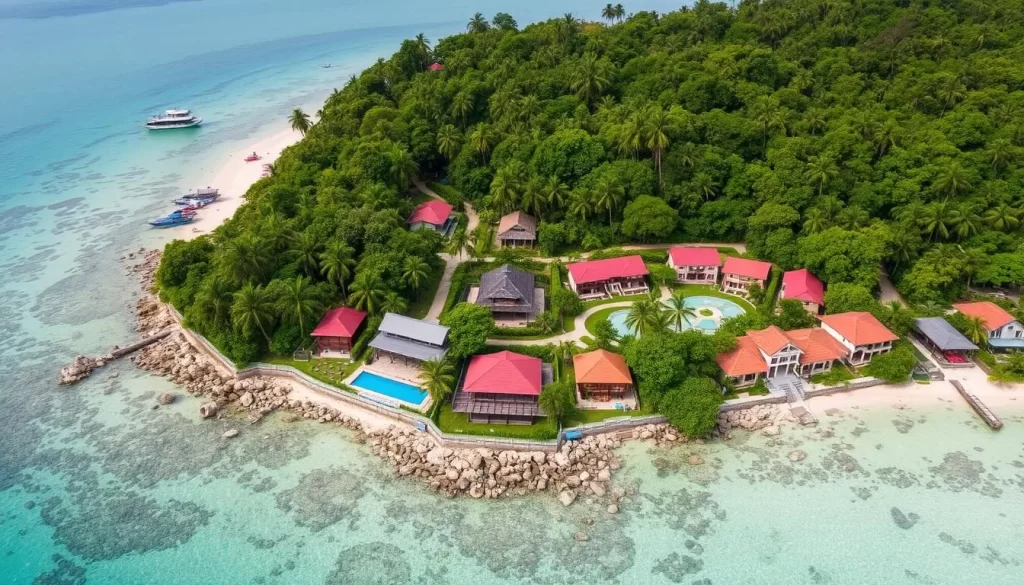
Luxury Option
Pangkor Laut Resort stands as the island’s premier luxury accommodation, situated on its own private island just off Pangkor’s coast. It offers exclusive villas either nestled in the hillside jungle or built on stilts over the water.
The resort features world-class amenities, including a renowned Spa Village, multiple gourmet restaurants, and private access to the stunning Emerald Bay.
Mid-Range Option
AVI Pangkor Beach Resort offers excellent value with its prime location directly opposite Pasir Bogak Beach. The resort features comfortable rooms with private balconies, an inviting swimming pool, and an on-site restaurant serving both local and international cuisine.
The modern rooms at AVI Pangkor come equipped with all essential amenities, making it a popular choice for families and couples.
Budget Option
Joe Fisherman Inn is an ideal choice for budget travelers, with its strategic location within walking distance of both Coral Beach and Teluk Nipah. The inn offers flexible room configurations that can accommodate everything from solo travelers to large groups.
The rooms are comforting and include wood paneling, a seating area, and TV, making it an island home away from home.
When choosing your accommodation, consider that most resorts are concentrated around Pasir Bogak and Teluk Nipah beaches, while budget options are more commonly found in Pangkor Town and the fishing villages.
Getting to Pangkor Island
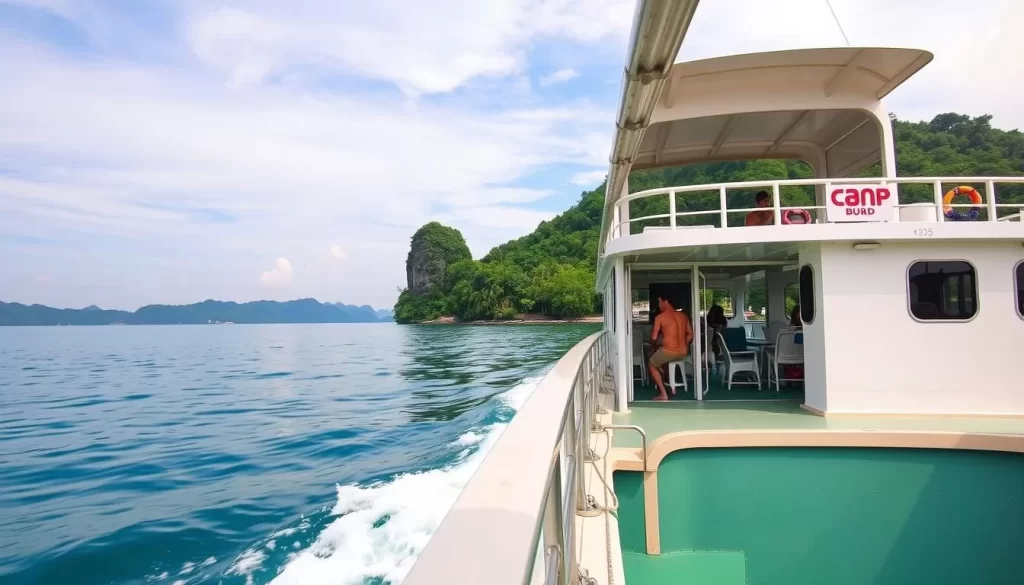
Your journey to Pangkor Island begins with a short ferry ride from Lumut Jetty on the Malaysian mainland. This is the primary way to reach the island, making Lumut Jetty a crucial gateway for visitors.
Ferry Services from Lumut Jetty
The ferry service from Lumut Jetty to Pangkor Island is convenient and relatively quick, taking approximately 30-45 minutes depending on sea conditions. Ferries depart roughly every hour from early morning until early evening, with return tickets costing around RM10. This makes it an affordable and practical option for travelers.
Transportation from Major Malaysian Cities
To get to Lumut Jetty, you can travel by car or bus from major Malaysian cities like Kuala Lumpur, Penang, and Ipoh. The journey from Kuala Lumpur takes about 4 hours via well-maintained highways, making it feasible for a weekend trip. Bus services operate regularly, and the Lumut bus station is within walking distance of the ferry terminal, simplifying your travel arrangements.
Getting Around Pangkor Island
Navigating Pangkor Island is straightforward, with a few convenient transportation options available. Since there’s no public transport on the island, you’ll rely on other means to explore its attractions.
Pink Taxis: The Island’s Iconic Transportation
The iconic pink taxis are the primary mode of transportation on Pangkor Island. These taxis are easily recognizable and can be found waiting near the ferry terminal and at designated taxi stops throughout the island. The fares are fixed and clearly displayed at the taxi stands, making it convenient for you to plan your journey. For instance, a ride between popular spots like Teluk Nipah and Coral Beach typically costs between RM10-20, depending on the distance.
For a comprehensive island tour, consider hiring a pink taxi for a round-island trip, which costs approximately RM80-100. This option allows you to visit most major attractions in just a few hours, making it an efficient way to explore the island in a single day.
Renting Bicycles and Motorbikes
Alternatively, you can rent bicycles or motorbikes to explore the island at your own pace. Daily rental rates range from RM10-20 for bicycles and RM30-50 for motorbikes. We recommend opting for motorbikes, as the island’s roads can be hilly. This flexibility allows you to create your own itinerary and enjoy the scenic views without being tied to a taxi schedule.
| Transportation Mode | Daily Rental Rate (RM) | Recommended For |
|---|---|---|
| Bicycles | 10-20 | Leisurely exploration, short distances |
| Motorbikes | 30-50 | Hilly terrain, longer distances, flexibility |
| Pink Taxis (Round Island Tour) | 80-100 | Comprehensive sightseeing, multiple attractions |
The island’s compact size means that most journeys between attractions take just 10-15 minutes by taxi or motorbike, allowing you to visit multiple sites in a single day without excessive travel time.
Best Time to Visit and Travel Tips
Pangkor Island, a hidden gem in Malaysia, is a year-round destination, but knowing the ideal time to visit can enhance your experience. With its stable tropical climate, you can plan your trip at any time of the year.
Weather Patterns and Peak Seasons
Pangkor Island enjoys favorable weather year-round, but February, March, June, and July offer the most consistent sunshine and calm seas, making these months ideal for beach activities and water sports. The wet season, from September to December, still allows for plenty of vacation activities despite short afternoon bursts of rainfall.
Practical Tips for Your Pangkor Island Trip
- Book your accommodation in advance, especially during weekends and Malaysian public holidays when areas like Pasir Bogak and Teluk Nipah get crowded.
- Bring sufficient cash, as ATMs are limited to the main town area, far from popular beaches and attractions.
- Pack essentials like reef-safe sunscreen, insect repellent, and modest clothing for temple visits.
Conclusion: Why Pangkor Island Should Be Your Next Malaysian Getaway
If you’re looking for a tropical paradise with a mix of natural beauty and cultural experiences, Pangkor Island is the perfect destination. This island offers a unique blend of relaxation, adventure, and cultural immersion, making it an ideal vacation spot for travelers of all preferences.
Pangkor Island caters to diverse interests, whether you’re looking to unwind on the golden sands of Pasir Bogak Beach, snorkel in the crystal-clear waters of Coral Beach, or indulge in luxury at Pangkor Laut Resort. The island’s compact size allows you to experience a variety of attractions in a short trip, from wildlife encounters to exploring historical sites like the Dutch Fort.
What sets Pangkor apart is its ability to maintain an authentic fishing village atmosphere alongside modern comforts and tourist facilities. For luxury seekers, Pangkor Laut Resort on its private island offers an unparalleled experience with overwater villas and jungle suites. This comprehensive guide has provided you with a list of the best things to do, hotels to stay in, and tips for getting around, making it your ultimate guide to planning the perfect island getaway.
In conclusion, Pangkor Island deserves a spot on your travel list, offering a mix of tropical beauty, cultural experiences, and memories that will last a lifetime.
